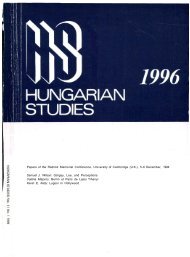The Canadian-American Review of Hungarian Studies - Vol. 4 ... - EPA
The Canadian-American Review of Hungarian Studies - Vol. 4 ... - EPA
The Canadian-American Review of Hungarian Studies - Vol. 4 ... - EPA
You also want an ePaper? Increase the reach of your titles
YUMPU automatically turns print PDFs into web optimized ePapers that Google loves.
imonthly appearing in 1,000 copies, while the latter is a quarterlyappearing in 500 copies. It is unlikely that these are capable <strong>of</strong> satisfyingan audience composed <strong>of</strong> 700,000 Calvinist, 700,000 Roman Catholic,50.000 Unitarian and 30,000 Evangelical readers (p. 23). 4<strong>The</strong> text <strong>of</strong> <strong>The</strong> <strong>Hungarian</strong> Nationality in Romania does not evenpossess the limited value <strong>of</strong> its annexes. It is clearly and simply apologia.Altogether the text is only twenty-one pages (pp. 5 26). It is divided int<strong>of</strong>our sections, providing a historical-demographic background, a briefreview <strong>of</strong> economic, political and social conditions, a discussion <strong>of</strong>educational and cultural opportunities and a summary <strong>of</strong> religiousrights as these relate to the <strong>Hungarian</strong>s.<strong>The</strong> presentation attempts to provide an easily understandable andfavorable picture <strong>of</strong> Rumania's treatment <strong>of</strong> its <strong>Hungarian</strong> population.It does not succeed for both stylistic and substantive reasons. Awkwardsentences, misspelled words (e.g., "monther tongue" p. 24, "jear" p. 43)and inappropriate word usage (e.g., "swap <strong>of</strong> experience" instead <strong>of</strong>"exchange <strong>of</strong> experience" p. 43) hinder an effective communication <strong>of</strong>the message. Similarly, substantive errors or distortions are bound toirritate the informed observers <strong>of</strong> East Central European affairs. Examples<strong>of</strong> the latter include the blurring <strong>of</strong> the significance <strong>of</strong> certainstatistics by relating them to an imprecise time perspective. In relationto the publication <strong>of</strong> religious books in <strong>Hungarian</strong>, the given statisticsare related to "the last few years" (p. 25). What does this mean? <strong>The</strong> lasttwo, five or ten years? Another example is the statement that DavidEerenc (1520 1579), the founder <strong>of</strong> <strong>Hungarian</strong> Unitarianism, was bornin Cluj-Napoca (p. 25). In 1520 there was no such city! To be historicallyaccurate, he was born in Kolozsvar [Klausenburg], today renamed Cluj-Napoca. This use <strong>of</strong> only Rumanian place names, even when they donot fit the context, is a recurring abuse. In the first section entitled"General Data", other questionable or misleading statements are alsomade. On p. 6, it is contended that the "<strong>Hungarian</strong> feudal state" onlycame into being "in the 12th century." On this same page it is alsocontended that the "Szecklers (i.e., Szekelys) . . . lived alongside theRomanians from whom they also learned the art <strong>of</strong> writing." It is indeedironic that such claims can be put forward when the only written sourceused by present day Rumanian historians to "prove continuity" inmedieval Transylvania is the Gesta Hungarorum <strong>of</strong> the <strong>Hungarian</strong> KingBela III.Julia Nanay's Transylvania: <strong>The</strong> <strong>Hungarian</strong> Minority in Rumania isnot as blatantly propagandistic. Yet, it is also ineffective in sheddinglight on the actual state <strong>of</strong> affairs in Transylvania. It, too, is weighted
















